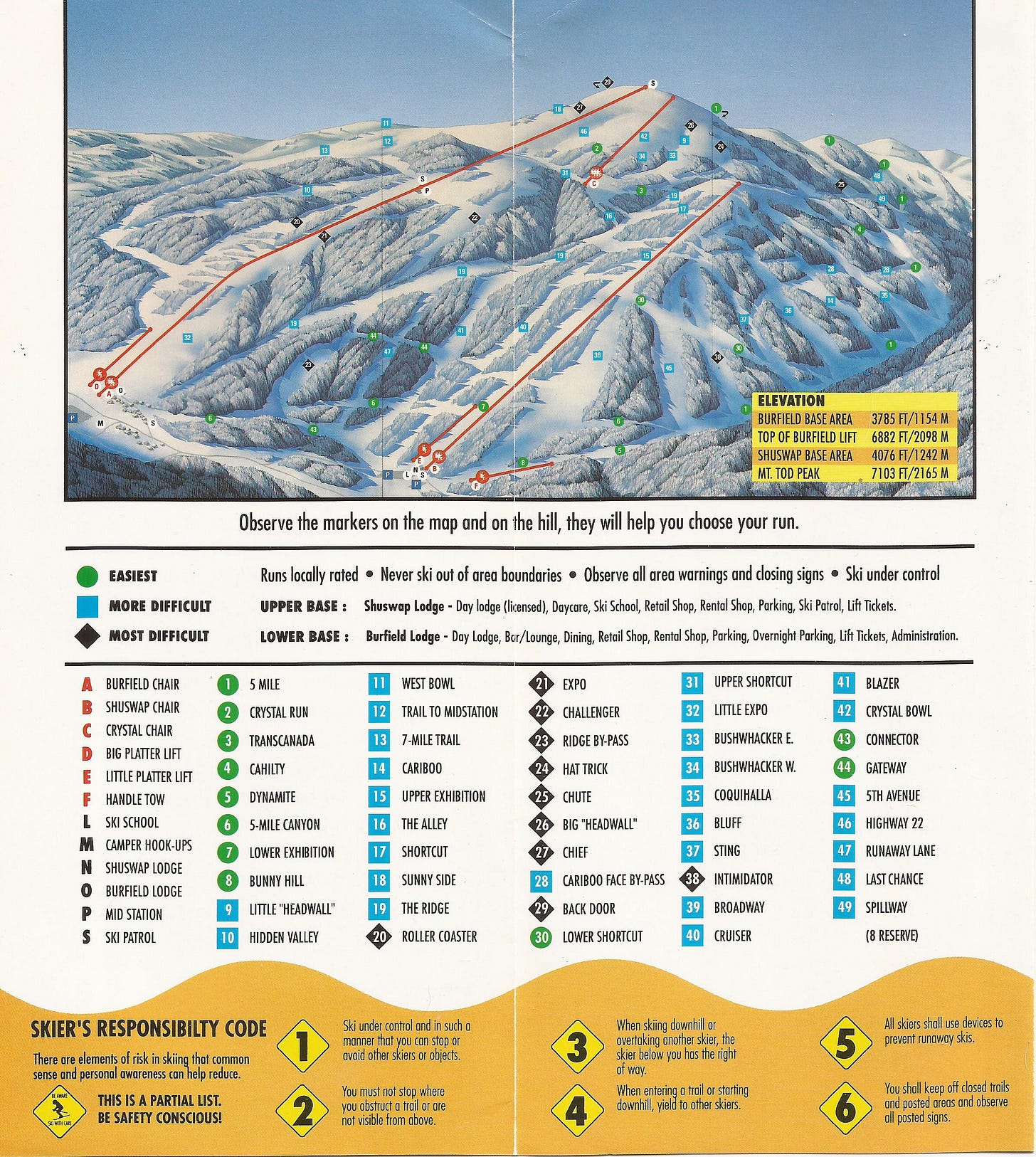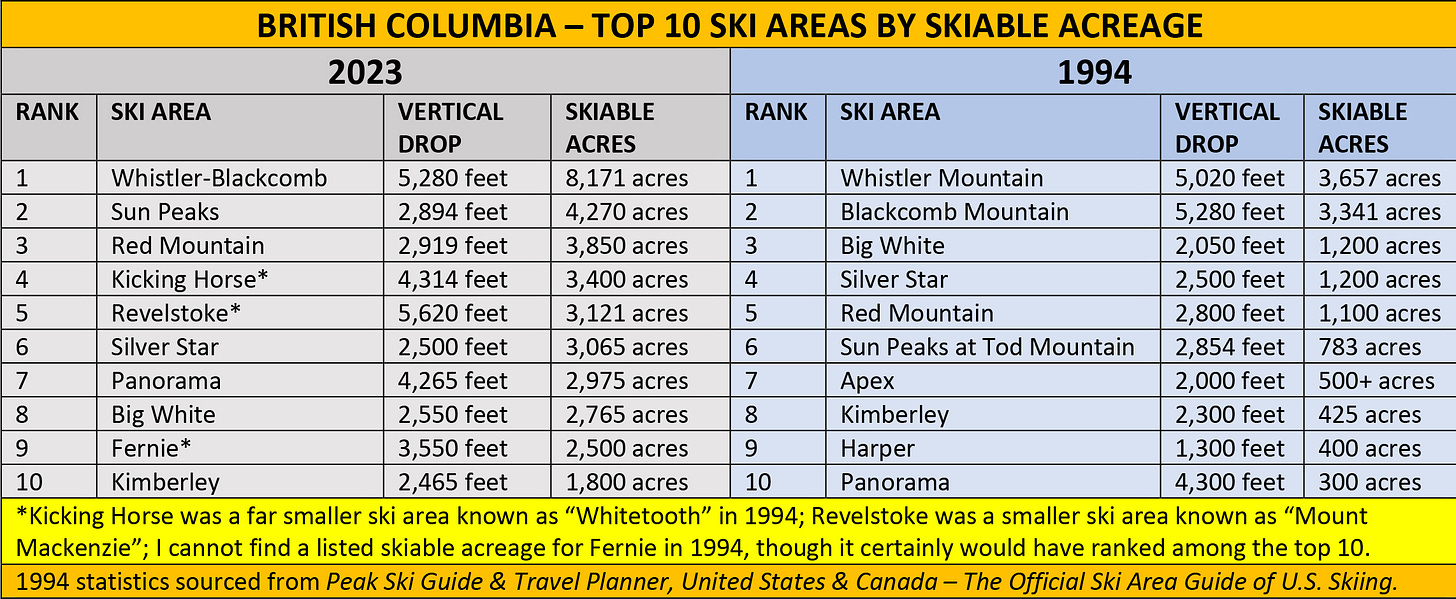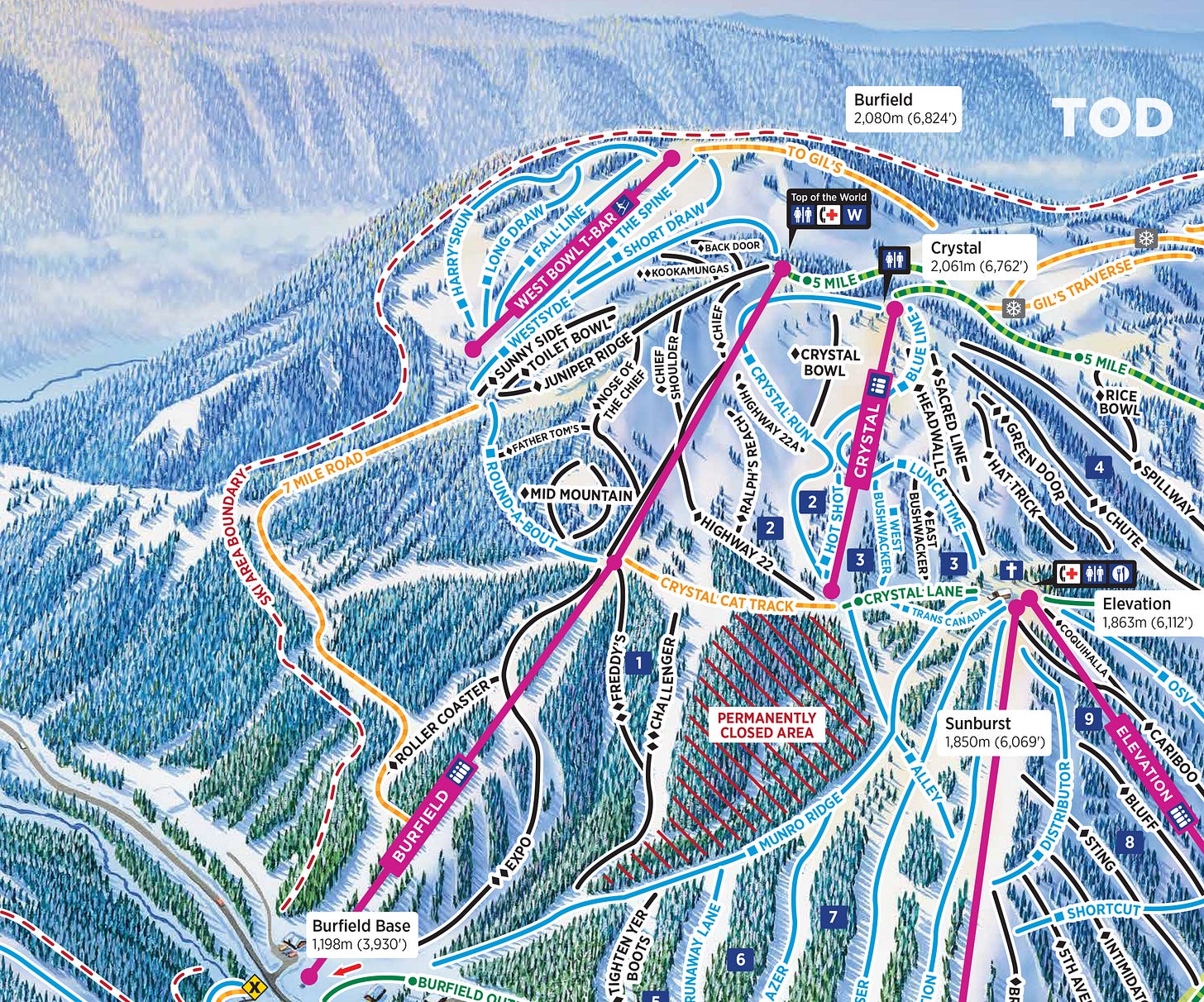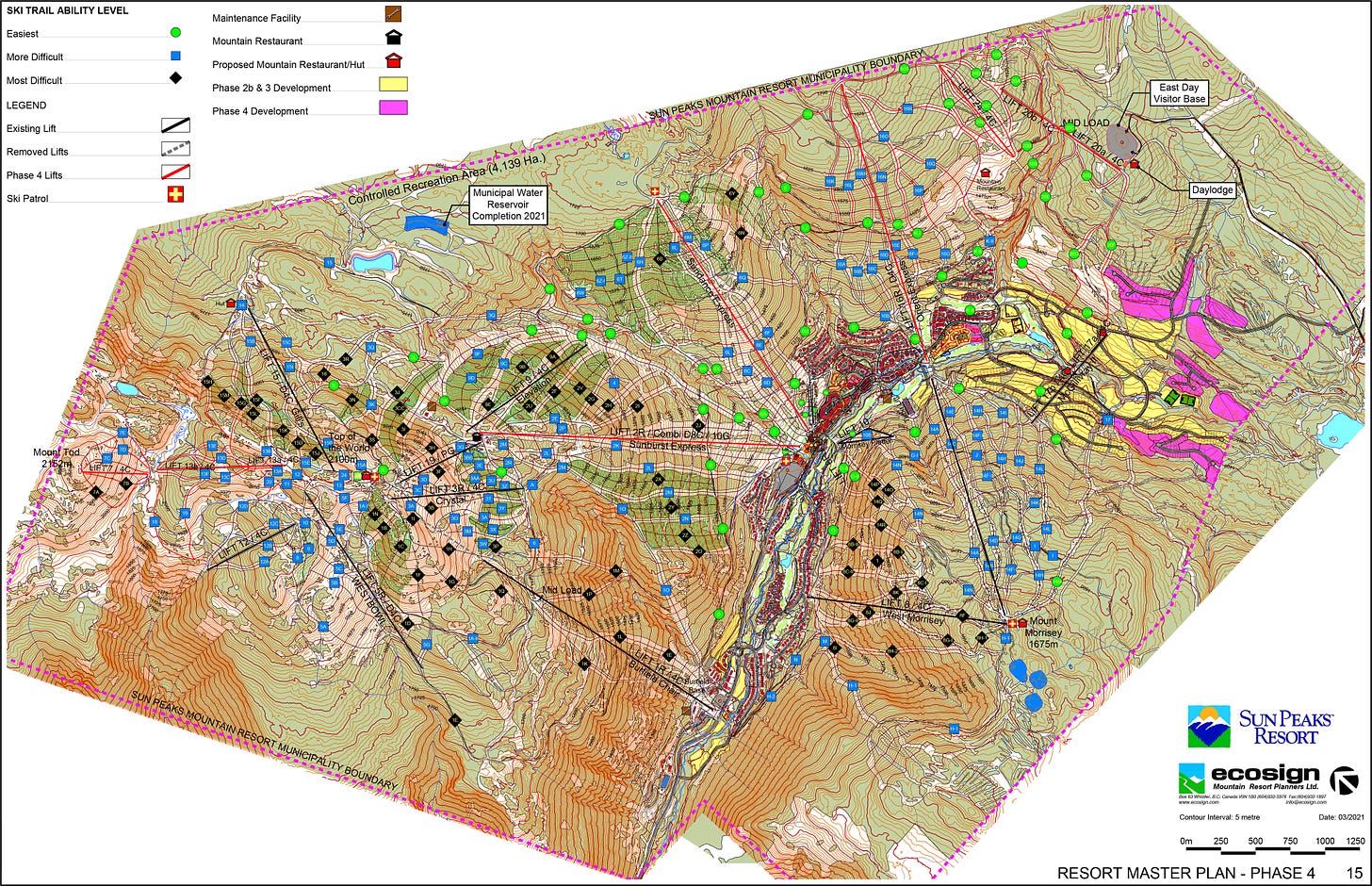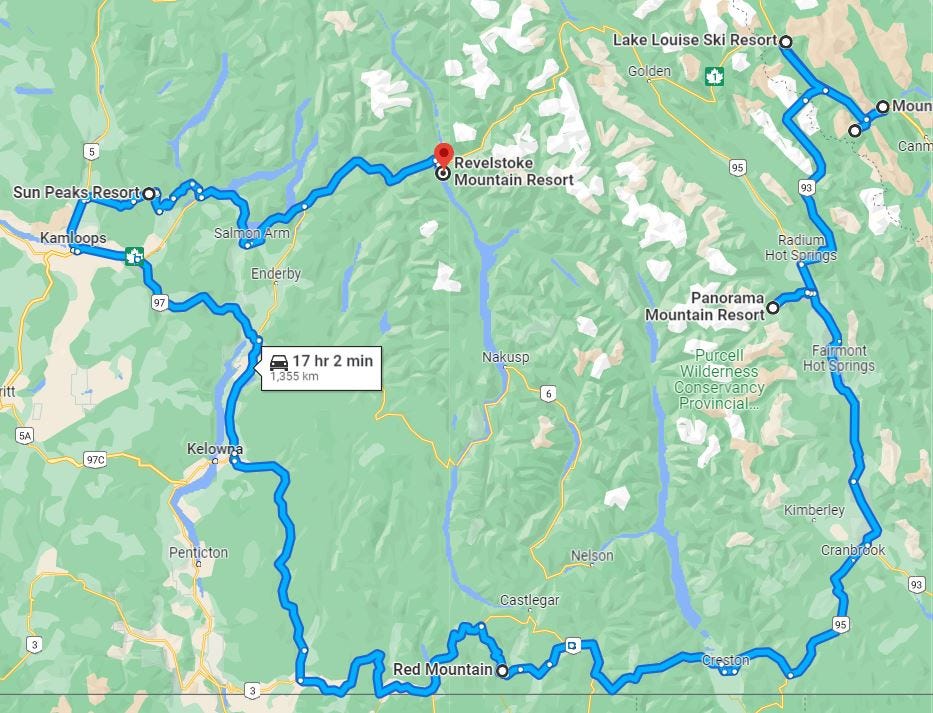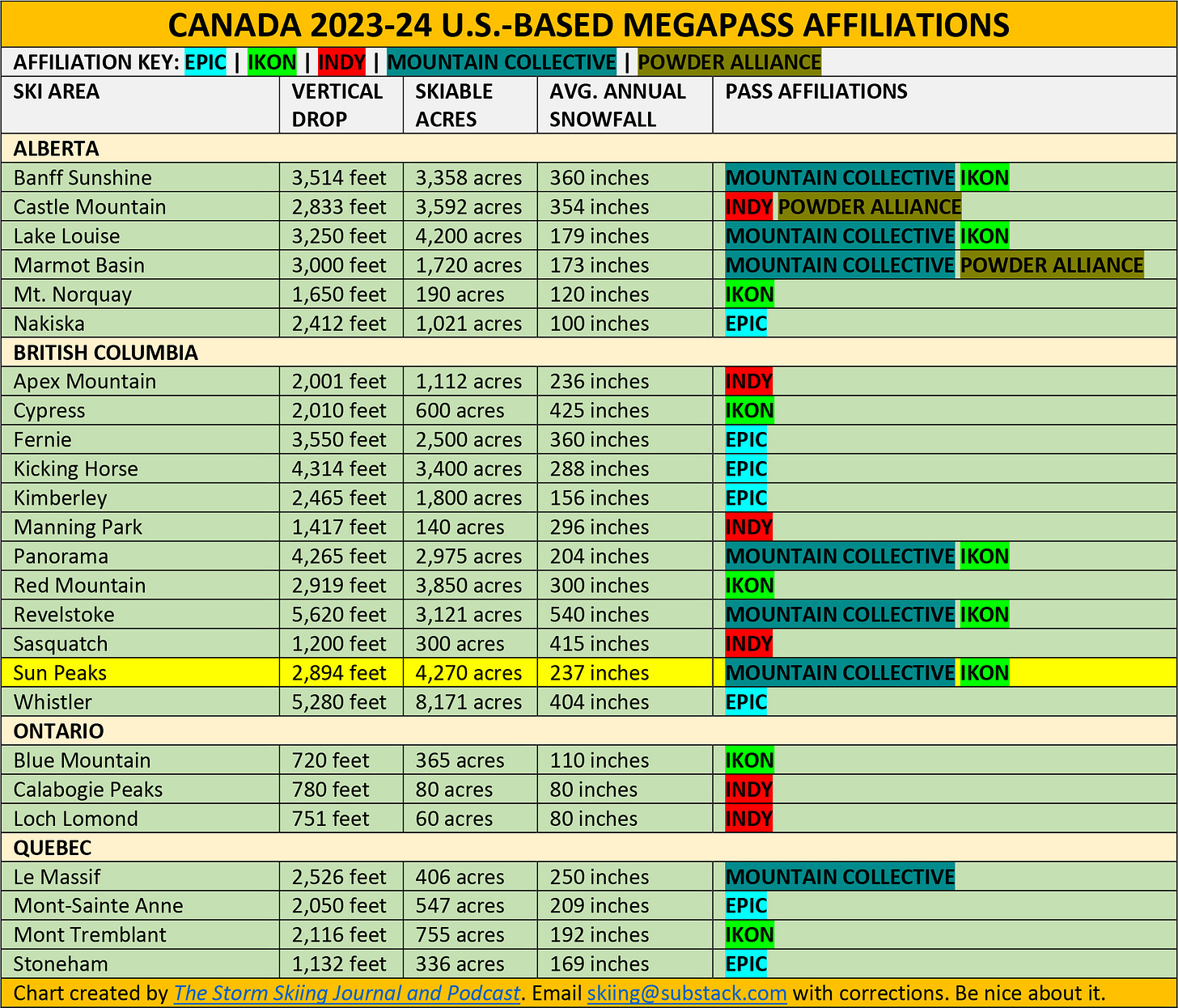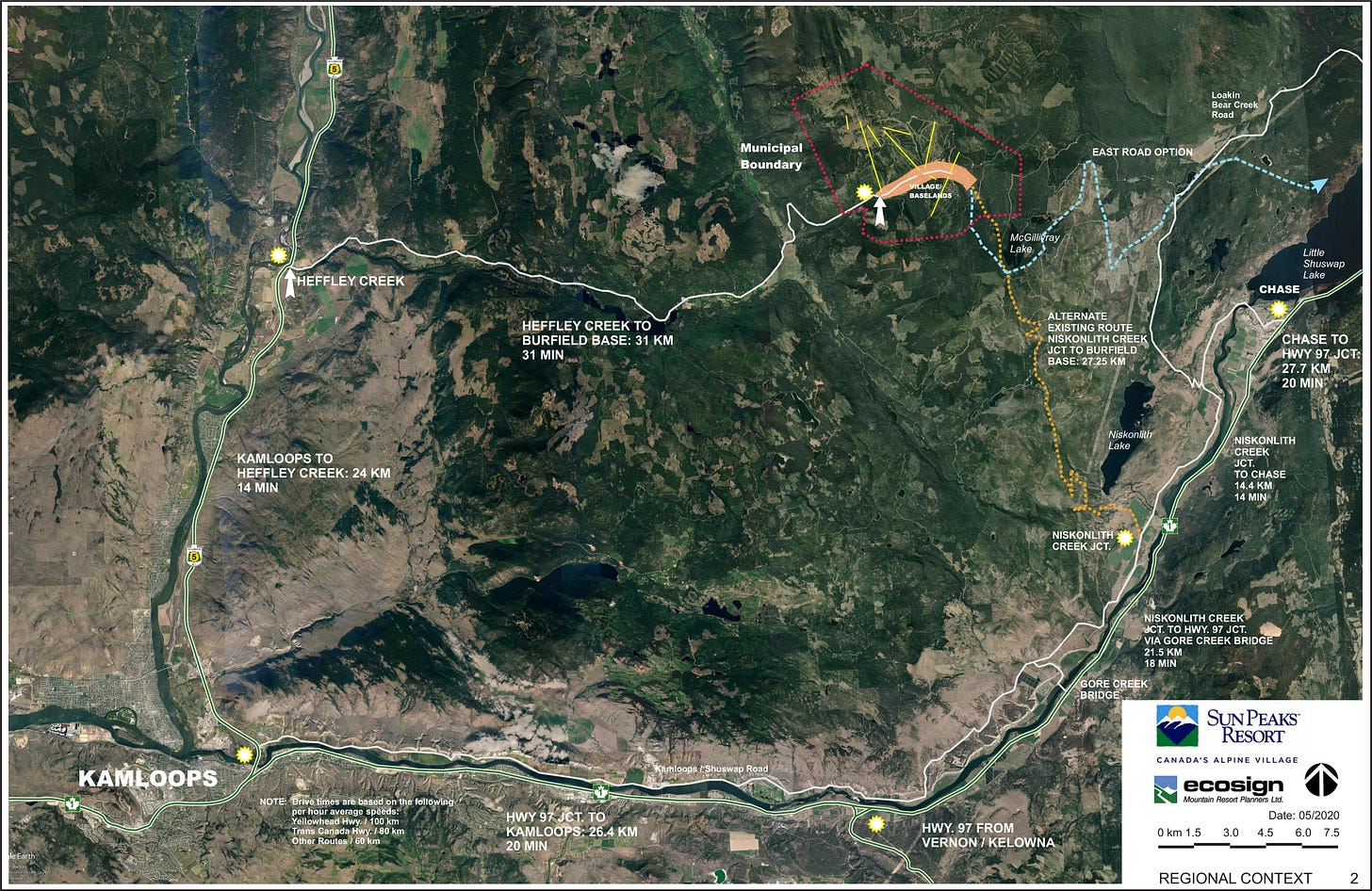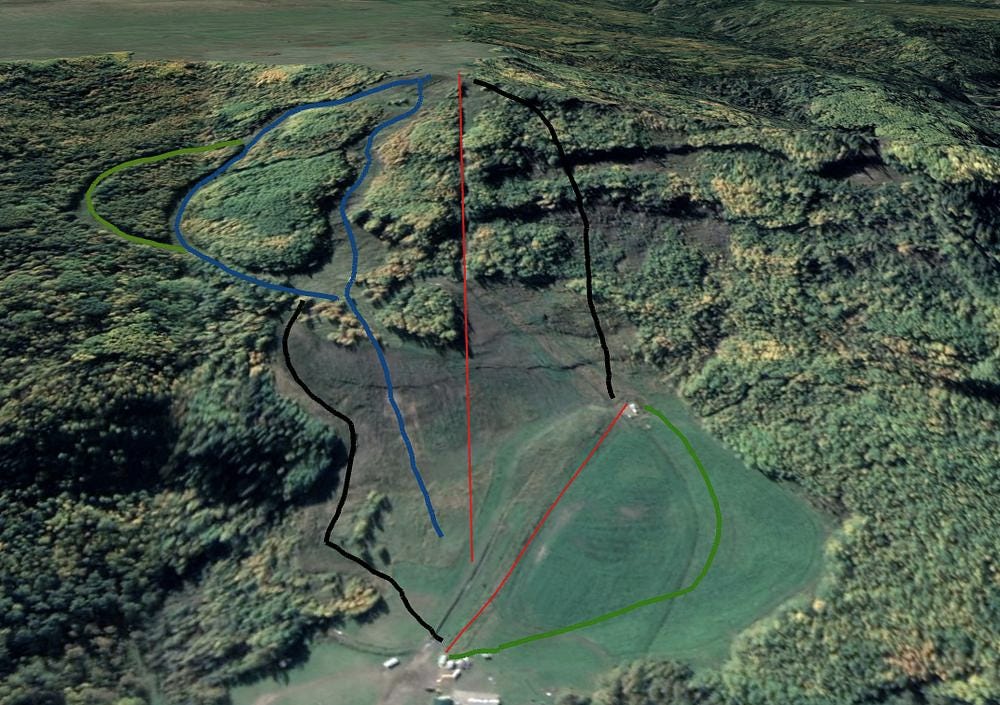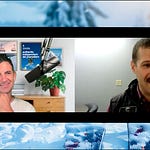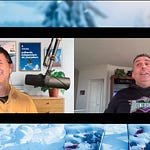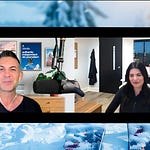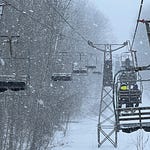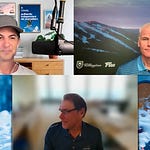Who
Darcy Alexander, Vice President and General Manager of Sun Peaks, British Columbia
Recorded on
May 23, 2023
About Sun Peaks
Click here for a mountain stats overview
Owned by: Nippon Cable Company
Located in: Sun Peaks, British Columbia
Year founded: 1961, as Tod Mountain
Pass affiliations: Ikon Pass: 5 or 7 days; Mountain Collective: 2 days
Reciprocal partners: 2 days at Silver Star
Closest neighboring ski areas: Harper Mountain (58 minutes), Silver Star (2 hours, 20 minutes)
Base elevation: 3,930 feet
Summit elevation: 6,824 feet
Vertical drop: 2,894 feet
Skiable Acres: 4,270
Average annual snowfall: 237 inches
Trail count: 138 trails and 19 glades (32% advanced/expert, 58% intermediate, 10% beginner)
Lift count: 13 (3 high-speed quads, 4 fixed-grip quads, 2 platters, 4 carpets - view Lift Blog’s inventory of Sun Peaks’ lift fleet) – Sun Peaks will build a fourth high-speed quad, West Bowl Express, in 2024
Why I interviewed him
Because this freaking province, man. Twenty-nine ski areas with vertical drops over 1,000 feet. Fourteen soar beyond 2,000. Five cross the 3,000-foot mark. Four pass 4,000. And BC is home to the only two ski areas in North America that give you 5,000 or more vertical feet: Whistler and King Revelstoke. Thirteen BC bumps deliver 1,000-plus acres of terrain, and at least 20 load up on 200 inches or more of snow per season. Check these stats:
British Columbia is like the Lamborghini dealership of skiing. Lots of power, lots of flash, lots of hot damn is that real? No duds. Nothing you’d be embarrassed to pick up a date in. A few community bumps, sure. But the BC Bros can stack their power towers – Big White, Fernie, Kicking Horse, Kimberley, Panorama, Red, Revelstoke, Silver Star, Sun Peaks, Whistler, and Whitewater – against any collection of ski areas anywhere on the planet and feel pretty good about winning that knife fight.
And yet, even in this Seal Team Six of ski resorts, Sun Peaks looks heroic, epaulets and medals dangling from its dress blues. This is the second-largest ski area in Canada. Ponder that BC ski roster again to understand what that means: Sun Peaks gives you more acreage than anything on the famed Powder Highway, more than Revy or Red or Kicking Horse or Fernie. Turn north at Kamloops, east at Hefley Creek, and get lost at the end of the valley.
But Sun Peaks’ sheer size is less impressive than how the resort won those big-mountain stats. “British Columbia has probably the most progressive ski resort development policy in the world,” Alexander tells me in the podcast. When he arrived at the bump that was then called “Tod Mountain” in 1993, the place was three chairlifts and some surface movers serving a single peak:
Over the next 30 years, Nippon Cable transformed the joint into a vast ski Narnia not only because they were willing to funnel vast capital into the hill, but because the BC government let them do it, under a set of rules known as the B.C. Commercial Alpine Ski policy. While inspiring, this is not an unusual ski area evolution tale for Western Canada. Compare the 10 largest BC ski areas today to the 10 largest in 1994:
The acreage explosions at all but Whistler-Blackcomb (which at the time operated as independent ski areas), are astonishing. To underscore the point, check out the same years’ comparison for the 10-largest U.S. ski areas:
Certainly, the U.S. has seen some dramatic shuffling, especially as Vail and Alterra combined Canyons with Park City and Alpine Meadows with the ski area formerly known as Squaw Valley to form the megaresorts of Park City and Palisades Tahoe. That Big Sky didn’t measure on the top 10 in 1994 – the tram didn’t arrive until 1995 – is amazing. But the Western U.S., in 1994, was already home to legions of enormous ski resorts. That Heavenly, Mammoth, and Jackson Hole are the exact same size today as they were 29 years ago illustrates the difference between the two countries’ attitudes toward ski resort expansion and development. Canada nurtures growth. The U.S. makes it as difficult as possible. Indeed, the reason Big Sky was able to ascend to monster status is that the resort sits entirely on private land, immunizing it from Forest Service bureaucracy and the endless public challenges that attend it.
Sun Peaks is a case study in BC’s development-friendly policies actualized. More important: the resort’s evolution is a case study in smart, transit-oriented, pedestrian-friendly development. Alexander explains in the podcast that the long-range goal has been to build not just walkable base villages, but a walkable community stretching from one end of the valley to the other. This is the point that’s so often missed in the United States: not all growth and development is bad. The reckless, developer-driven, luxury-focused, disconnected sprawl that is U.S. America’s default building mode is terrible and inhuman and ought to be curtailed. Deliberate, dense, interconnected, metered development based upon a community masterplan - which is what Sun Peaks is doing - should be encouraged.
This sort of thoughtful growth does not dilute mountain communities. It creates them. Rather than trying to freeze development in time – a posture that only kicks sprawl ever farther out from the mountains and leads directly to the traffic addling so many Western U.S. ski towns – BC has enabled and empowered the sort of place-building that will create sustainable mountain communities over the long term. It’s an inspiring model, and one that The Storm will examine intensely as I focus more deliberately on Canada.
What we talked about
Record skier visits; bringing back that international vibe; touring Western Canada; Sun Peaks’ first season on the Ikon Pass; the secret giant; how to dodge what few liftlines the resort has; the Mountain Collective as Ikon test run; Tod Mountain in the early 1990s; ski area masterplanning; Sunshine Village; growing Sun Peaks from backwater to the second-largest ski area in Canada; Nippon Cable, the Japanese lift manufacturer that owns Sun Peaks; why Sun Peaks doesn’t use Nippon lifts; why Sun Peaks changed its name from “Tod Mountain” in 1993; an interesting tidbit about Whistler ownership; whether Sun Peaks ever considered joining the Epic Pass; Sun Peaks’ masterplan; potential terrain expansions; upgrade potential for Sunburst and Sundance lifts; future lift additions; “the guy who serves the most ski terrain with the fewest lifts is the most efficient”; going deep on the coming West Bowl Express quad and the new terrain that will go along with it; why Sun Peaks retired the West Bowl T-bar before replacing it; better access to Gil’s; why Sun Peaks is building the lift over three summers; the amazing Burfield lift, a fixed-grip quad that stretches nearly 3,000 vertical feet; potentially shortening that lift; why Burfield will likely never be a high-speed lift; prioritizing lift projects after West Bowl; converting – not replacing – Orient from a fixed-grip quad to a high-speed quad or six-pack; village-building; the potential major lift that’s not on Sun Peaks’ masterplan; and potentially connecting the resort to the Trans-Canada highway by paved road from the east.
Why I thought that now was a good time for this interview
In April, Sun Peaks announced construction of a new high-speed quad in West Bowl for the 2024-25 ski season. The lift will replace the West Bowl T-bar, visible on this circa 2019 trailmap, on a longer line that pushes the boundary away from the 7 Mile Road trail:
The resort will lengthen the existing trails to meet the new lift’s load point down the mountain, as Alexander explains in the podcast.
This will be Sun Peaks’ third new chairlift in three years, following new fixed-grip quads at Crystal and Orient in 2020 and 2018, respectively. Sun Peaks approaches chairlift construction in a unique manner, with a history of building lifts as fixed-grip machines and then upgrading them to high-speed lifts later on. Orient, for example, may evolve into a high-speed six-pack that lands several hundred more feet up the mountain. Slowly, deliberately, endlessly, Sun Peaks grows and evolves.
While Alexander and his team continue to stack bricks into the resort’s foundation, they simultaneously grow the mountain’s profile. A few years back, the resort joined the Mountain Collective. Last October, it joined Ikon. And, kaboom: no more secret at the end of the road.
That’s a good thing. If these BC giants are to thrive, they’re going to need help outside the province, which hosts a population of approximately 5 million in an area the size of California (39 million residents), Colorado (5.8 million), and Utah (3.4 million) combined. That means bringing skiers burned out on Summit County and Wasatch liftlines across the border, where big ski resorts continue to get bigger and the liftlines rarely form (outside of the West Coast).
I don’t want to overstate the scale of what’s happening in BC – certainly big projects still can and do happen in America. And even as they grow fat by North American standards, most of the province’s biggest ski areas still look like birdbaths compared to the ski circuses of Europe. But imagine if, over the next 30 years, 480-acre Ski Cooper transformed into 5,317-acre Vail Mountain. That is essentially what’s happened at Sun Peaks since 1993, where a small community bump evolved into an international destination resort 10 times its original size. And they’re nowhere near finished – Sun Peaks’ masterplan (pg. 141), outlines a monster facility at full build-out:
The Mountain Master Plan … will ultimately include a total of 26 ski lifts, including one pulse gondola, one 10G/8C Combi lift one detachable grip six-passenger chairlift, four detachable quadruple chairlifts, nine fixed grip quadruple chairlifts, four platter lifts and approximately two beginner moving carpet lifts, with a total combined rated capacity of about 41,186 passengers per hour … The overall Phase 4 [Skier Comfortable Carrying Capacity] will be approximately 14,830 skiers per day. … there will be 225 trails providing 177.5 kilometers of skiing on [1,895 acres] of terrain.
Here’s a conceptual map of Sun Peaks at full build-out:
While plenty of BC ski areas have evolved over the past several decades, no one has accomplished the trick more steadily or with such deliberate, constant momentum as Sun Peaks. It was time to check in to see how they’d done it, and what was going to happen next.
What I got wrong
As is my habit, I introduced Sun Peaks as defined by our U.S. American measurement system of feet and acres. Which is not that unusual – this is a U.S. American-based podcast. However, as a courtesy to my Canadian guests, listeners, and readers, I should have also offered the equivalent measurements in meters. Only I am a dumb U.S. American so I don’t actually know how to do these conversions. Sorry about that.
Why you should ski Sun Peaks
The Ikon Pass is an incredible thing. Purchase one in the spring and spend the following winter bouncing across the snowy horizons. Hit half a dozen of the continent’s greatest resorts in Utah, big-mountain hop in Colorado, spend a week in Tahoe or skimming between peaks at Big Sky. Or go to Canada – 10 Ikon destinations sit in the northland, and seven of them crouch in a neat circle straddling BC and Alberta: Norquay, Lake Louise, Sunshine, Panorama, Red, Sun Peaks, and Revelstoke:
You could complete that circle in around 17 hours of driving. Which is not much if you’re rolling through a two-week roadie and spending two or three days at each resort. Some of them could occupy far more time. Sun Peaks can eat up a week pretty easily. But for the resort-hoppers among us, an Ikon or Mountain Collective pass includes days at Canada’s second-largest ski area on its ready-to-eat buffet. Here’s a look at every Canadian ski area that participates in a U.S.-based megapass:
So the first reason to ski Sun Peaks is that you probably already have access to it. But there’s something else – you can just go there and ski. As much as I love the ski resorts of Colorado and Utah, they are just too easy to access for too many people. That’s great, but skiing in those powder holes requires a certain patience, an expectation of some kind of madness, a willingness to tweak the algorithm to see what combination of snowfall, open terrain, day of the week, and time of day yields the most open path between you and turns.
That calculus is a little easier at Sun Peaks: just show up whenever you want and start skiing. Outside of Whistler, the big-mountain resorts of BC resemble the big-mountain resorts of the American West 40 years ago. Endless labyrinths of untamed terrain, no one to race off the ropeline. BC’s collective ski resorts have evolved much faster than the market’s realization that there is another set of Rocky Mountain resorts stacked on top of the Rocky Mountain resorts of U.S. America. That’s a lot of terrain to roam. And all you need is a passport. Go get it.
Podcast Notes
On building an alternate route into Sun Peaks from the east
Most visitors to Sun Peaks are going to spend some time traveling to the resort along the Trans-Canada Highway. Eastbound travelers will simply turn north at Kamloops and then right at Heffley Creek. Westbound travelers pass within five miles of the resort’s southeast edge as they drive through Chase, but must continue toward Kamloops before turning toward Sun Peaks – nearly an hour and a half on clear roads. There is a mountain road, unpaved and impassable in wintertime (marked in yellow below), and long-simmering plans for an alternate, less death-defying paved path that could be open year-round (market in blue below). Alexander and I discussed this road, and he seemed optimistic that it will, eventually, get built. Given Sun Peaks’ record of actualizing the improbable, I share his outlook. Here’s a map of the whole mess:
On Nippon Cable and Whistler
While Sun Peaks presents as an independent ski area, it is in fact part of a Japan-based conglomerate called Nippon Cable. This is primarily a lift manufacturer, but Nippon also owns a number of ski areas in Japan and 25 percent of Whistler (seriously). Read more about their properties here.
On Big Bam ski area
Alexander mentions Big Bam ski area, which sits along the Pine River just west of the Alaska Highway and south of Fort St. John. Here’s a homemade trailmap that someone codenamed “Skier72” posted on skimap.org, with the caption, “Approx. Trails at Big Bam. Made with Google Earth. Top lift is future quad chair, bottom lift is rope tow”:
Big Bam is a volunteer-run, weekends-only organization with 180 feet of vert. You can follow them on Facebook (their last Instapost was in 2014). Alexander mentioned that the ski area had moved from its original location, though I couldn’t find any information on the old hill. The place has had a rough go – it re-opened (I believe in the current location), in 2009, and was closed from 2016 to 2019 before turning the lifts on again. They seem desperate for a chairlift. If anyone knows more about the Big Bam story, please let me know.
On Sun Peaks spare lift fleet
Alexander notes that Sun Peaks “might have the least number of lifts for a resort of our size” on the continent. Indeed, the ski area has the third-fewest number of lifts among North America’s 10 largest ski areas:
On the Burfield chairlift
Stow this one for ski club trivia night: Sun Peaks is home to what is very likely the longest fixed-grip chairlift in the world. The Burfield quad rises 2,890 vertical feet on a 9,510-foot-long line. According to Lift Blog, ride time is 21 minutes, and the carriers are 115 feet apart. The lift’s hourly capacity is just 470 riders – compare that to the Crystal fixed-grip quad right beside it, which can move up to 2,400 skiers per hour.
The Storm publishes year-round, and guarantees 100 articles per year. This is article 50/100 in 2023, and number 436 since launching on Oct. 13, 2019. Want to send feedback? Reply to this email and I will answer (unless you sound insane, or, more likely, I just get busy). You can also email skiing@substack.com.






